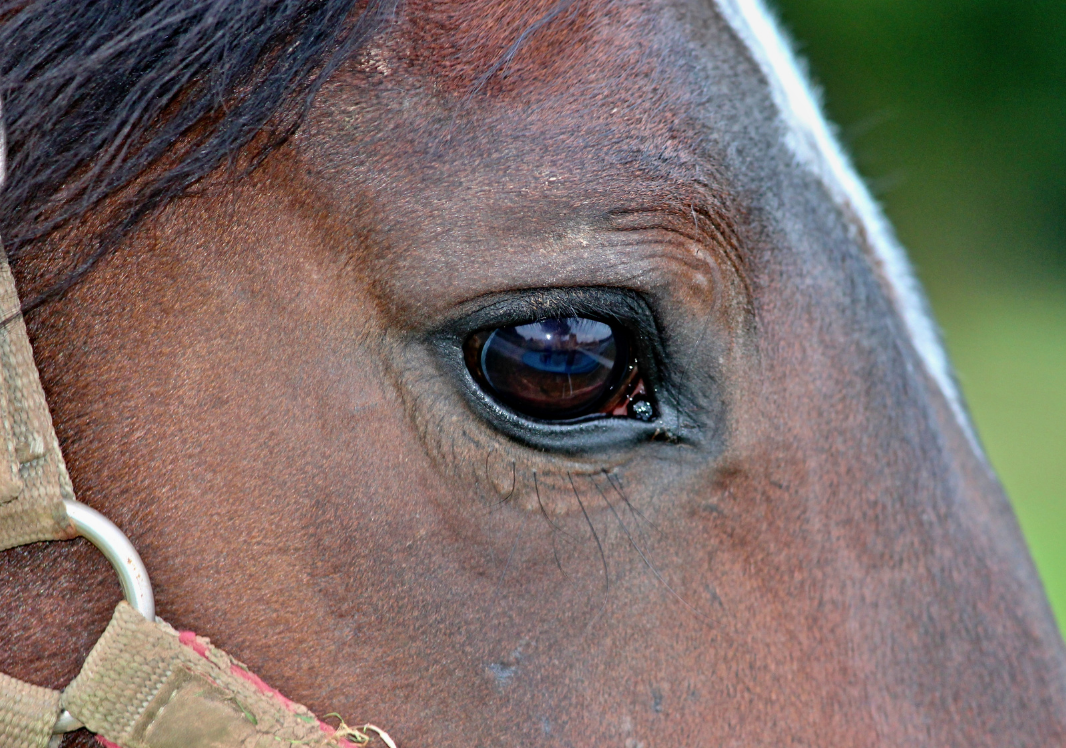Have you ever gazed into the lovely, liquid and soulful eyes of your horse or pony and wondered whether he sees the world as you do? Can he see colours, for example, or make out the details of your smile? Does he take in the view from his paddock or while you’re out on a hack, and why does he spook at seemingly innocuous items?
Like most things to do with equines, the answers to these questions lie in the complex genetic make-up of a horse and the way various things like vision have evolved in the wild to make him resilient to threats and help him find food.
The first amazing fact to note about the equine eye is the fact that they have the largest eyes of all the land mammals (well ostriches do have bigger eyes, but then they are technically birds!).
Secondly, did you know that if you stand head-on to your horse, in front of his forehead, or directly behind his tail, he won’t see you at all?
BLIND SPOTS
As you know, horses’ eyes are situated on either side of the head, giving them “binocular” vision – they can view their environment on both sides. Their forward vision however is limited to aiming down the nose, rather than straight ahead, so your horse has a blind spot directly in front of him. Similarly, although your horse has a large field of vision to the side and rear with each eye, he can’t see what’s straight behind his tail.
Fortunately he is able to rectify this by simply moving his head.
The positioning of a horse’s eyes, though, give him panoramic vision on a horizontal plane – very difficult to imagine for us humans. Studies have shown that a horse can see as much as 200° in a circular aspect with the monocular vision of each eye. This means there is little in the surroundings that will escape his attention, particularly if it moves! If you can see his eyes while riding he can probably even see you on his back!
This remarkable ability is believed to have evolved in order to protect him from predators sneaking up on him from either side, or even, largely, from behind. Makes sense, as the horse was originally a prey animal.
While he’s grazing your horse will direct his vision downwards, but he’s still aware of his surroundings and if something moves in his wide perimeter, he’ll lift his head for a better view and bring his binocular vision to bear, and have a good look.
He’s programmed to investigate anything that catches his eye, which is what makes him prick up his ears and raise his head if something disturbing enters his peripheral vision.

VISUAL ACUITY
So now you are probably wondering how clearly your horse sees his surroundings. Does he get a sharp, focused image of anything in that wide peripheral vision of his?
We don’t know for sure, but science has established that he sees detail best in front of his eyes. This is because he needs to identify what he’s eating and what the ground conditions are like if he’s moving. Apparently (how they measure this I don’t know!) it’s still not as clear a picture as we humans would get – a bit blurry – but good enough for the horse’s purpose.
The further around in his panorama a potential moving threat is, the more blurred his sight of a disturbing object is. This is why even a leaf blowing or a plastic bag caught on a fence can send him into panic mode.
NIGHT VISION & DISTANCE JUDGEMENT
At night horses see better than humans. This is down to the size of the eye and therefore the fact that they have more rod cells in the light sensitive area of the eye. Their eyes do take awhile to adjust, however, which is why they are sometimes reluctant to enter a dark stable directly from being out in the sun. This could also explain why shaded areas on a cross country course could be troublesome.
They can judge distance quickly and accurately, because they need to jump over things in their path while fleeing predators. Translated in the modern world to their ability to size up and conquer a jump.
COLOUR & DETAIL
According to Wikipedia horses are not colour blind, but they do have dichromatic vision, which means they see only blue and green colours (unlike humans who have trichromic vision). This doesn’t mean they see only things that are green and blue, but their sprectrum limits them to shades of those colours. They don’t see red, for example, which is probably a good thing! It means your purple matchy-matchy set is probably not doing much for them aesthetically! Reds appear more green.
This is because they only have two types of cones in their eyes …. All to do with light wavelengths.
Take this into account when building fancy colourful jumps and setting up arena equipment.
Last, but by no means least, you need to know if your horse CAN see your facial expressions when you hug him. Well, sad to say his close vision is probably not exceptional, but take comfort in the fact that horses are sensitive to feelings … he’ll recognize you with senses other than vision. It’s been found that horses can make facial expressions just like humans (as I’m sure you know) so take comfort in the fact that you don’t have to dress up to impress your horse visually … just be there for him!
Take care of your horse’s amazing eyes. Cleaning eyes should be part of your regular grooming process. He’s looking to you to take care of him! Contact us for advice on horse eye problems.



